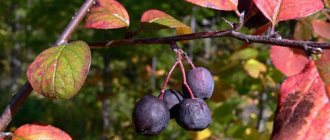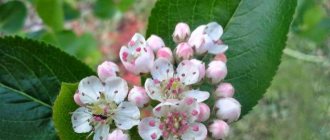A living composition of plants is becoming an integral element of modern landscape design. Many bright flowers are replaced by deciduous shrubs. Among them, brilliant cotoneaster is popular, a multifunctional option for decorating a personal plot. Let's look at the characteristics of the plant and its role in decorating the area.
One of the best shrubs for a self-sufficient garden is considered to be cotoneaster (Cotoneaster) from the Rosaceae family.
The use of cotoneaster in garden landscape design
The ornamental shrub is very common in gardens. The culture looks harmonious in any garden composition. Dense branching and ease of care make the plant indispensable for creating low borders and living fences. Green fencing can withstand any conditions, which is why cotoneaster is used to decorate not only suburban areas, but also public gardens, park areas and highways in cities.
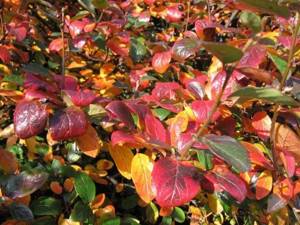
The genus of cotoneaster includes more than 40 species, of which about ten are now used in landscape design - this is the common cotoneaster, horizontal, shiny.
Cotoneaster is one of the few representatives of the flora used to strengthen the soil. On soil susceptible to corrosion, the plant grows quickly, holds the soil together and prevents its further destruction. In landscape design, crops are planted to strengthen the coastal zone and slopes.

Cotoneaster is a large deciduous bush, strewn with smooth leaves of rich green color, lush inflorescences and bearing inedible but beautiful dark berries.
Due to its slow growth, the shrub is suitable for creating topiary haircuts. The plant is given a variety of shapes, ranging from simple balls to complex geometric shapes. If you follow certain rules, giving the desired shape is not difficult.
Low-growing varieties are ideal for forming a shrubby lawn. It perfectly masks problem areas of the garden and is a good replacement for ordinary grass cover.

It tolerates pruning well and grows slowly, making it an excellent base for use as a landscape ornament.
Cotoneaster brilliant is a universal plant; it looks impressive both in single and in group plantings. The variety of sizes and shapes allows you to use the crop to create any composition. And this is not surprising, because the genus Cotoneaster consists of low-growing and erect varieties of different sizes and colors of leaves and fruits. In addition, white and soft pink flowers add special beauty to the space, and the ability of the leaves to change shade effectively dilutes the familiar landscape in autumn.
In group compositions, the plant is combined with representatives of coniferous species. Low species are used in rockeries and rock gardens. Cotoneaster goes well with stone and other garden compositions.
For reference! Thanks to its frost resistance and ability to grow in one place for a long time, a cotoneaster hedge retains its decorative value at any time of the year.

In fall, the foliage changes color, delighting gardeners with a wide range of reds and purples with flashes of orange and yellow.
Meet the brilliant cotoneaster
An ornamental deciduous shrub is simply strewn with small, smooth, shiny dark green ovoid leaves. Cotoneaster flowering begins at the end of May and lasts about a month. At this time, spectacular lush pink inflorescences appear against a background of dark greenery. Each inflorescence can have from 6 to 12 flowers. Individually, the flowers are nothing special, but collected in corymbs, they amaze with their splendor.
Cotoneaster brilliant
The fragrant aroma during flowering attracts many bees. And by September the cotoneaster fruits ripen. Black berries can remain on the bushes until spring. But they are not eaten due to the lack of any taste. Gardeners use them as a medicine.
In autumn, the brilliant cotoneaster is especially beautiful. The bushes are decorated with foliage of different shades. Red, purple, yellow, orange leaves are adjacent to bright greenery. All this splendor glitters under the rays of the sun. And the berries become even more noticeable.
Cotoneaster brilliant can be propagated by seeds collected independently from ripened fruits. All characteristics of the mother plant are preserved.
The plant belongs to the Rosaceae family. The bushes reach a height of two meters, but they grow very slowly, respond well to pruning, and are unpretentious in care. That is why a cotoneaster hedge will serve as a real decoration of the garden for many years.
Advantages and disadvantages of cotoneaster for hedges
There are many benefits to using the shiny appearance of cotoneaster to create a living fence. The shrub perfectly complements any plant composition, and does not require special care from the gardener.

This unpretentious plant is easily propagated by all existing methods.
Among the main advantages of the plant are:
- beautiful appearance (from the early spring months until late autumn, a living fence pleases with bright greenery, beautiful flowering and rich shades of fruits);
- good growth and reproduction in places with a polluted atmosphere (not afraid of dust, soot, polluted air);
- possibility of planting in shady areas;
- unpretentiousness to soil composition;
- tolerance to drought and frost;
- rarely exposed to disease and invasion of harmful insects;
- the ability to implement different design ideas in the landscape of the site (giving any shape);
- longevity, the planted bush grows for 50 years;
- attracting pollinating insects (cotoneaster is a good honey plant).
The disadvantages of the plant include:
- slow growth (15-20 cm per season);
- repeated trimming of bushes during the season, otherwise the bush loses its shape and decorative appearance (at least 3-4 times);
- small height of the hedge (no more than 2 m, the obstacle can be easily overcome);
- under certain weather conditions it is prone to fungal infection.

For reference!
Cotoneaster does not tolerate stagnant moisture in the soil. To build a hedge, high-quality soil drainage is necessary.
Collection and storage of fruits
The difficulty in collecting berries, which ripen depending on the variety in September - early November, lies in their inability to stay on the branches when ripe. However, this feature is compensated by the possibility of collecting fruits in an unripe form, after which they successfully ripen.
Ripe fruits are stored at temperatures close to zero. Under such storage conditions, they do not lose their consumer properties for 2 weeks. For storage throughout the year, dogwood fruits are frozen. The process preserves all the numerous nutrients in the berries. And, of course, a wonderful way to store berries is the famous dogwood jam.
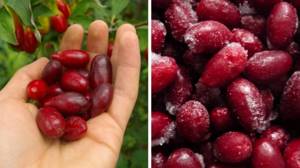
Cotoneaster hedge: basic requirements for planting and plant care
If the owner of a personal plot is interested in the idea of zoning it with a hedge, then it will be useful to familiarize yourself with some recommendations for planting a plant.
Landing
To make the fence dense, seedlings are planted at intervals of 0.5 m. This is the minimum value; if desired, the distance can be increased. You can plant cotoneaster in a checkerboard pattern; this pattern is quite popular in landscape design.
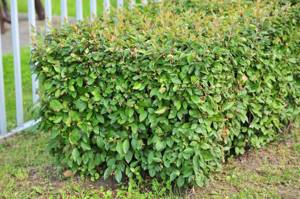
The plant should be watered as soil is added; it is recommended to feed it with urea.
The interval for planting seedlings largely depends on the final result that the owner of the private territory wants to obtain. If you need a thin and high hedge, then planting is done in one row of 3 bushes per 1 linear meter (30-40 cm from each other). For those who want to get a low and wide fence, you should follow the order: plant in two rows of 4-5 bushes per 1 linear meter (in a checkerboard pattern). It is not advisable to plant the plant in three rows. This form of planting can cause slow growth and fungal infections.

Cotoneaster needs regular pruning.
The best time to plant cotoneaster is spring and autumn. In autumn, suitable months are from the end of September to the beginning of November. Seedlings must take root before frost. In spring, planting is carried out before buds bloom on the shoots.
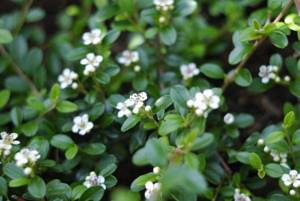
For rapid growth and harmonious development of the shrub, you need to monitor its appearance.
Care
The shrub does not require special conditions for the composition of the soil. But for better growth, it is recommended to add a little peat, humus, sand and compost. Chalk and lime are also added to the prepared soil (300 g per 1 sq.m.).
In the first year after planting, seedlings are provided with regular watering, once every two weeks. In hot weather, the frequency of watering is increased.
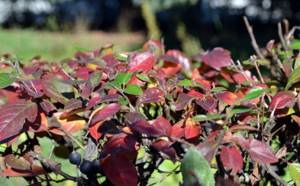
Typically, cotoneaster is not susceptible to disease, but sometimes garden “criminals” make an attempt on its life.
To maintain a beautiful and well-groomed appearance, regular trimming of bushes is carried out. To give clear boundaries when pruning, use rope and trellis shears. You should not ignore sanitary pruning to remove old and damaged branches.

Garden designers advise periodically giving the bushes their shape.
With the onset of spring, fertilizing is added. Dilute 1 tablespoon of mineral fertilizers per 10 liters of water.
In frosty winters, the roots of young seedlings are protected from freezing by mulching or covering with covering material.
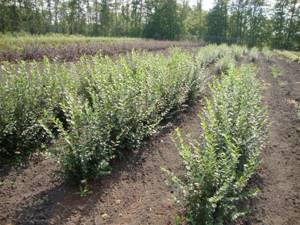
The brilliant cotoneaster is an unpretentious beauty, a modest provincial aristocrat who will not require unnecessary attention, but will be very grateful for unexpected care.
Shaping and trimming - recommendations with photographs
After planting, the seedlings grow freely for two years. And only after this period of time they begin to form a hedge of decorative brilliant cotoneaster.
First of all, the plant is limited in height by pinching out the upper shoots. Such actions stimulate the growth of lateral branches. Then the boundaries of growth of lateral shoots are outlined. As soon as the branches go beyond its limits, they begin to trim them.

The brilliant cotoneaster is combined with other varieties, the bushes can be alternated.
When forming a fence, it is important to take into account that the width of the lower part should be 10-15 cm greater than the upper part. The result is a kind of trapezoid that prevents shading of the slowly growing lower layers. Every year, the length of the shoots is increased by 5-7 cm until the bush crop reaches the desired height.
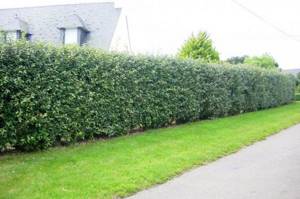
High living “walls” are most often used for zoning or serve as a fence.
By pruning, you can give the hedge any shape. Cotoneaster brilliant, hedge, photos of common forms:
- square;
- rectangular;
- trapezoidal;
- triangular.
Creating triangular and trapezoidal shapes requires special effort and experience. Some owners of living fences give unusual shapes, for example, a wave.
For reference! To create a living fence in landscape design, a horizontal variety of cotoneaster is widely in demand. It is characterized by accelerated growth and dense growth in width.
This variety is evergreen, with a maximum height of 0.5 m. It blooms with dark pink flowers in the spring, and in the fall it pleases garden owners with bright fruits that last throughout the winter. Horizontal cotoneaster in landscape design, see photo of the hedge below.
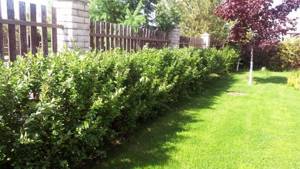
With good treatment and proper care, it can delight you and your guests with shine and bright colors for many years.
Reproduction methods
Cotoneasters are propagated by seeds, which definitely need stratification, cuttings, layering, and grafting, if they are used as a rootstock for a pear.
Cotoneasters are also propagated by lignified (winter) cuttings. To do this, the shoots are harvested in late autumn or early winter and stored in sand in basements. Only in the spring do they start cutting cuttings 10-20 cm long with three or five buds, which are subsequently rooted in the same way as green ones.
When propagating by seed, benign mature seeds are selected from mature cotoneaster fruits. They are washed from the pulp and soaked in water. In this case, up to 60% of defective seeds usually float to the surface, which are removed, leaving only viable ones.
Cotoneasters do not have a very high germination rate of seeds, because the seeds are in a state of deep dormancy, that is, they germinate for a very long time; some shoots appear only the following spring.










